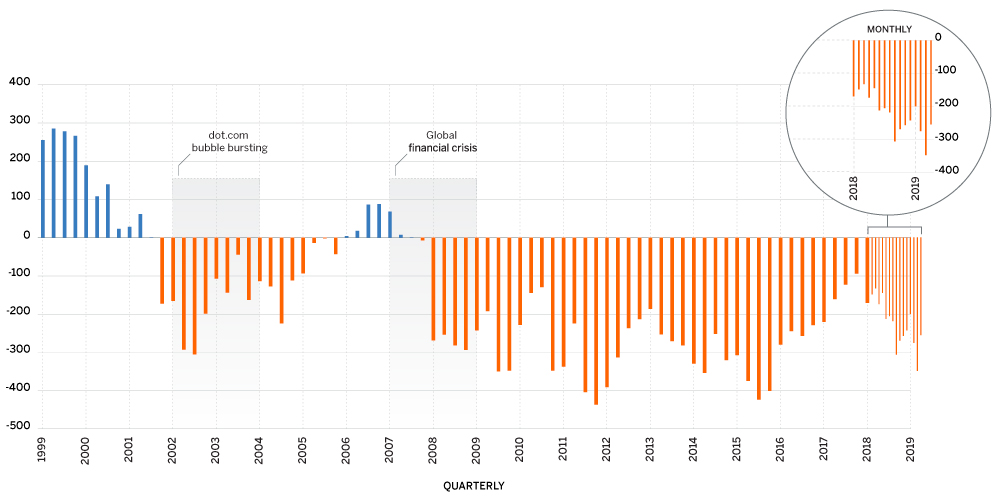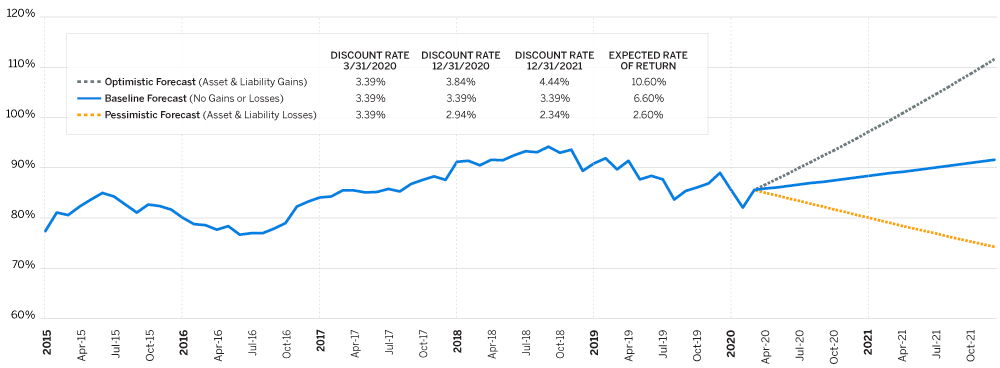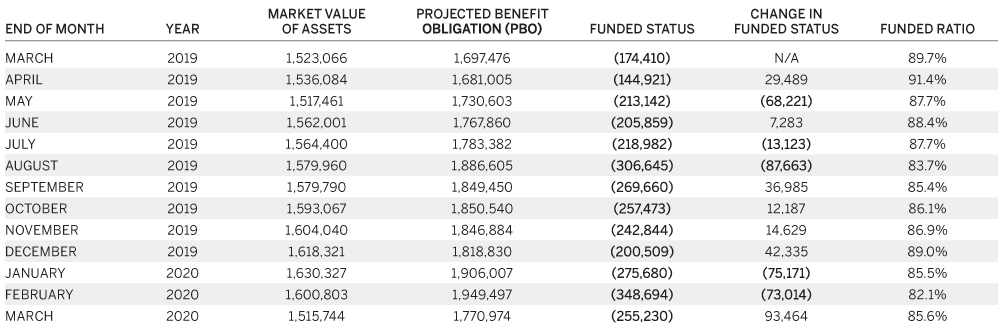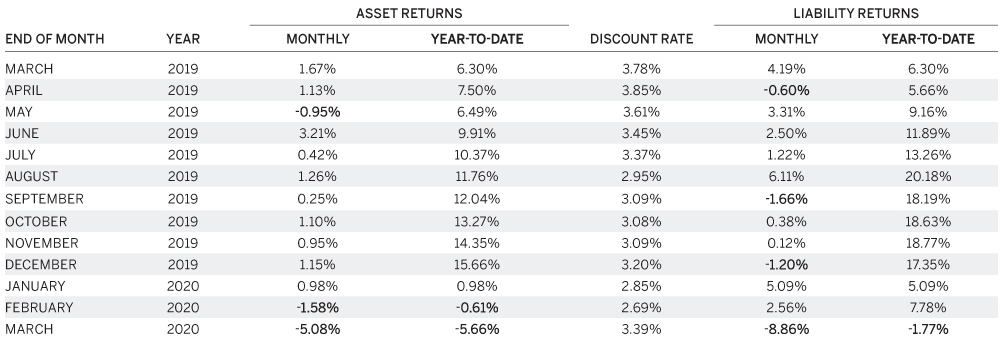Milliman analysis: Corporate pensions in March see surprising $93 billion funded status gain from massive surge in discount rates, despite heavy investment losses
Milliman 100 PFI funded ratio improves to 85.6%
The funded status of the 100 largest corporate defined benefit pension plans rose by $93 billion during March as measured by the Milliman 100 Pension Funding Index (PFI). The funded status deficit improved to $255 billion at the end of March 2020 due to a record increase in the benchmark corporate bond interest rates used to value pension liabilities. This funded status gain was partially offset by the precipitous decline in investment returns during March. As the decline in pension liabilities outweighed the decline in pension assets, the March 31 funded ratio increased to 85.6%, up from 82.1% at the end of February.
The market value of assets fell by $85 billion as a result of March’s sharp market decline. The Milliman 100 PFI asset value decreased to $1.516 trillion from $1.601 trillion at the end of February based on a monthly return of -5.08%. Only five other months in the last two decades have posted more severe investment losses, the last occurring in October of 2008 during the Great Recession. By comparison, the 2019 Milliman Pension Funding Study reported that the monthly median expected investment return during 2018 was 0.53% (6.6% annualized). The expected rate of return for 2019 will be updated in the 2020 Milliman Pension Funding Study, due out later this month.
Highlights
| $ BILLION | ||||
| MV | PBO | FUNDED STATUS | FUNDED PERCENTAGE | |
|---|---|---|---|---|
| FEBRUARY | 1,601 | 1,949 | (349) | 82.1% |
| MARCH | 1,516 | 1,771 | (255) | 85.6% |
| MONTHLY CHANGE | (85) | (179) | +93 | 3.5% |
| YTD CHANGE | (103) | (48) | (55) | -3.4% |
Note: Numbers may not add up precisely due to rounding
The projected benefit obligation (PBO), or pension liabilities, decreased to $1.771 trillion at the end of March. The change resulted from an increase of 70 basis points in the monthly discount rate, to 3.39% for March from 2.69% for February 2020.
FIGURE 1: MILLIMAN 100 PENSION FUNDING INDEX PENSION SURPLUS/DEFICIT

FIGURE 2: MILLIMAN 100 PENSION FUNDING INDEX — PENSION FUNDED RATIO

February’s discount rate was the lowest discount recorded in the 20-year history of the Milliman 100 PFI, while March’s discount rate increase is the 5th largest ever-recorded in our study. The last time the discount rate posted a comparable increase was in December 2009.
First Quarter 2020 Summary
For the quarter ending March 31, 2020, assets fell by $103 billion compared to plan liabilities, which increased by $48 billion. While investment returns were -5.7% during the first quarter of 2020, discount rates rose 19 basis points and helped to limit the funded status erosion. The net result was a funded status worsening of $55 billion. The funded status deficit grew to $255 billion by the end of the first quarter. The funded ratio of the Milliman 100 companies decreased to 85.6% at the end of March from 89.0% at the beginning of 2020.
Over the last 12 months (Apr. 2019 – Mar. 2020), the cumulative asset return for these pensions has been 2.6% and the Milliman 100 PFI funded status deficit has worsened by $81 billion. The funded status loss is the combined result of declines in discount rates during most of 2019 and investment losses experienced during the first quarter of 2020. Discount rates one year ago were 3.78%, compared to 3.39% as of March 31, 2020, signifying a 39-basis-point drop over the last 12 months.
The projected asset and liability figures presented in this analysis will be adjusted as part of Milliman’s annual 2020 Pension Funding Study including summarizing and reporting the most recent plan sponsor SEC financials. The 2020 PFS will also reflect reported pension settlement and annuity purchase activities that occurred during 2019. De-risking transactions generally result in reductions in pension funded status since the assets paid to the participants or assumed by the insurance companies as part of the risk transfer are larger than the corresponding liabilities that are extinguished from the balance sheets. To offset this decrease effect, many companies engaging in de-risking transactions make additional cash contributions to their pension plans to improve the plan’s funded status.
2020-2021 Projections
If the Milliman 100 PFI companies were to achieve the expected 6.6% median asset return (as per the 2019 pension funding study), and if the current discount rate of 3.39% were maintained during years 2020 through 2021, we forecast that the funded status of the surveyed plans would increase. This would result in a projected pension deficit of $210 billion (funded ratio of 88.1%) by the end of 2020 and a projected pension deficit of $148 billion (funded ratio of 91.6%) by the end of 2021. For purposes of this forecast, we have assumed 2020 and 2021 aggregate annual contributions of $50 billion.
Under an optimistic forecast with rising interest rates (reaching 3.84% by the end of 2020 and 4.44% by the end of 2021) and asset gains (10.6% annual returns), the funded ratio would climb to 96% by the end of 2020 and 112% by the end of 2021. Under a pessimistic forecast with similar interest rate and asset movements (2.94% discount rate at the end of 2020 and 2.34% by the end of 2021 and 2.6% annual returns), the funded ratio would decline to 81% by the end of 2020 and 74% by the end of 2021.
MILLIMAN 100 PENSION FUNDING INDEX — MARCH 2020 (ALL DOLLAR AMOUNTS IN MILLIONS)

PENSION ASSET AND LIABILITY RETURNS

About the Milliman 100 Monthly Pension Funding Index
For the past 19 years, Milliman has conducted an annual study of the 100 largest defined benefit pension plans sponsored by U.S. public companies. The Milliman 100 Pension Funding Index projects the funded status for pension plans included in our study, reflecting the impact of market returns and interest rate changes on pension funded status, utilizing the actual reported asset values, liabilities, and asset allocations of the companies’ pension plans.
The results of the Milliman 100 Pension Funding Index were based on the actual pension plan accounting information disclosed in the footnotes to the companies’ annual reports for the 2018 fiscal year and for previous fiscal years. This pension plan accounting disclosure information was summarized as part of the Milliman 2019 Pension Funding Study, which was published on April 16, 2019. In addition to providing the financial information on the funded status of U.S. qualified pension plans, the footnotes may also include figures for the companies’ nonqualified and foreign plans, both of which are often unfunded or subject to different funding standards than those for U.S. qualified pension plans. They do not represent the funded status of the companies’ U.S. qualified pension plans under ERISA.